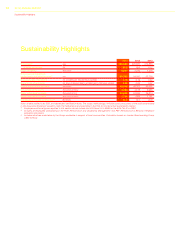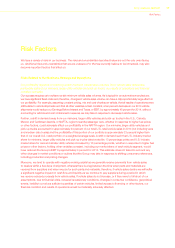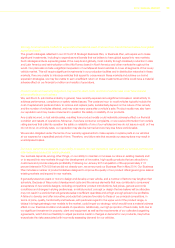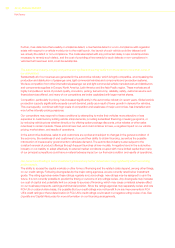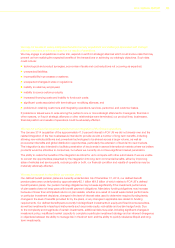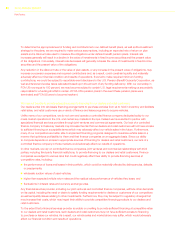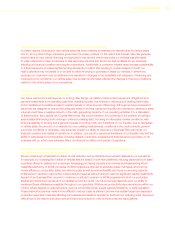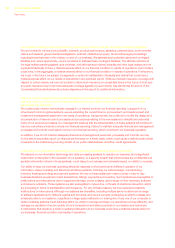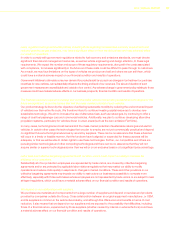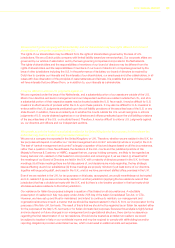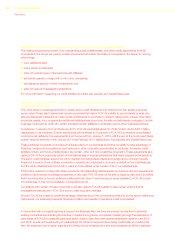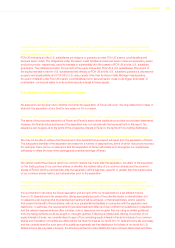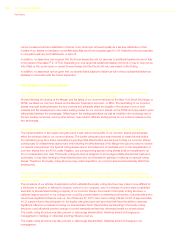Chrysler 2014 Annual Report Download - page 26
Download and view the complete annual report
Please find page 26 of the 2014 Chrysler annual report below. You can navigate through the pages in the report by either clicking on the pages listed below, or by using the keyword search tool below to find specific information within the annual report.
24 2014 | ANNUAL REPORT
Risk Factors
Our business operations may be impacted by various types of claims, lawsuits, and other contingent obligations.
We are involved in various product liability, warranty, product performance, asbestos, personal injury, environmental
claims and lawsuits, governmental investigations, antitrust, intellectual property, tax and other legal proceedings
including those that arise in the ordinary course of our business. We estimate such potential claims and contingent
liabilities and, where appropriate, record provisions to address these contingent liabilities. The ultimate outcome of
the legal matters pending against us is uncertain, and although such claims, lawsuits and other legal matters are not
expected individually to have a material adverse effect on our financial condition or results of operations, such matters
could have, in the aggregate, a material adverse effect on our financial condition or results of operations. Furthermore,
we could, in the future, be subject to judgments or enter into settlements of lawsuits and claims that could have a
material adverse effect on our results of operations in any particular period. While we maintain insurance coverage with
respect to certain claims, we may not be able to obtain such insurance on acceptable terms in the future, if at all, and
any such insurance may not provide adequate coverage against any such claims. See also Notes 26 and 33 of the
Consolidated financial statements included elsewhere in this report for additional information.
Failure to maintain adequate financial and management processes and controls could lead to errors in our financial
reporting, which could harm our business reputation and cause a default under certain covenants in our credit
agreements and other debt.
We continuously monitor and evaluate changes in our internal controls over financial reporting. In support of our
drive toward common global systems, we are extending the current finance, procurement, and capital project and
investment management systems to new areas of operations. As appropriate, we continue to modify the design and
documentation of internal control processes and procedures relating to the new systems to simplify and automate
many of our previous processes. Our management believes that the implementation of these systems will continue to
improve and enhance internal controls over financial reporting. Failure to maintain adequate financial and management
processes and controls could lead to errors in our financial reporting, which could harm our business reputation.
In addition, if we do not maintain adequate financial and management personnel, processes and controls, we may
not be able to accurately report our financial performance on a timely basis, which could cause a default under certain
covenants in the indentures governing certain of our public indebtedness, and other credit agreements.
A disruption in our information technology could compromise confidential and sensitive information.
We depend on our information technology and data processing systems to operate our business, and a significant
malfunction or disruption in the operation of our systems, or a security breach that compromises the confidential and
sensitive information stored in those systems, could disrupt our business and adversely impact our ability to compete.
Our ability to keep our business operating effectively depends on the functional and efficient operation of our
information, data processing and telecommunications systems, including our vehicle design, manufacturing,
inventory tracking and billing and payment systems. We rely on these systems to make a variety of day-to-day
business decisions as well as to track transactions, billings, payments and inventory. Such systems are susceptible to
malfunctions and interruptions due to equipment damage, power outages, and a range of other hardware, software
and network problems. Those systems are also susceptible to cybercrime, or threats of intentional disruption, which
are increasing in terms of sophistication and frequency. For any of these reasons, we may experience systems
malfunctions or interruptions. Although our systems are diversified, including multiple server locations and a range
of software applications for different regions and functions, and we are currently undergoing an effort to assess and
ameliorate risks to our systems, a significant or large-scale malfunction or interruption of any one of our computer or
data processing systems could adversely affect our ability to manage and keep our operations running efficiently, and
damage our reputation if we are unable to track transactions and deliver products to our dealers and customers.
A malfunction that results in a wider or sustained disruption to our business could have a material adverse effect on
our business, financial condition and results of operations.


